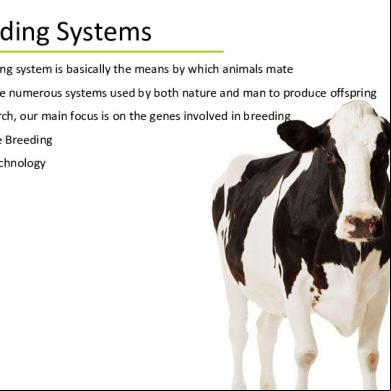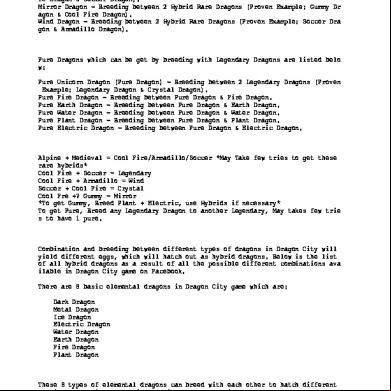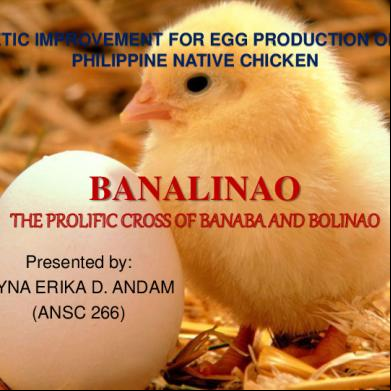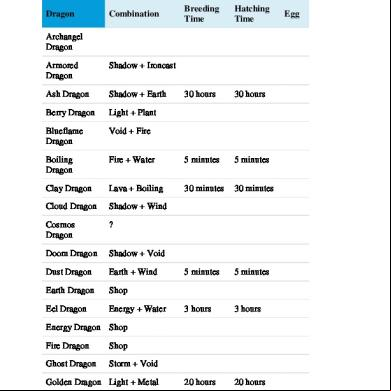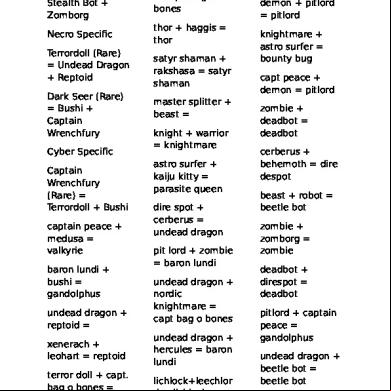Breeding Systems 1274k
This document was ed by and they confirmed that they have the permission to share it. If you are author or own the copyright of this book, please report to us by using this report form. Report 3b7i
Overview 3e4r5l
& View Breeding Systems as PDF for free.
More details w3441
- Words: 1,331
- Pages: 28
Breeding Systems •A breeding system is basically the means by which animals mate
•There are numerous systems used by both nature and man to produce offspring •In research, our main focus is on the genes involved in breeding •Selective Breeding •Gene Technology
Breeding Systems – Selective Breeding •Used by humans for centuries, initially starting to improve food resources
•The vast majority of the plants and animals we use today have been ‘cultivated’ (selected) on the basis of some phenotype e.g. faster growing, more abundant yield, better colour •Commonly used in cattle, sheep, horses, dogs, cats •Sires and dames chosen for selected characteristics
Breeding Systems – Selective Breeding http://learn.genetics.utah.edu/content/variation/artificial/
Breeding Systems – Selective Breeding •The rate of change (improvement) of a particular characteristic depends on three factors:
1 – the heritability of the characteristic 2 – the superiority (strength) of the particular character in the chosen stock 3 – the environment the animal is maintained in i.e genetic potential will not be reached if the environment is unsuitable
Different breeding strategies are used in selective breeding: •Random breeding
•Inreeding •Line Breeding •Outbreeding
Breeding Systems – Selective Breeding Random Breeding •Where an organism is equally likely to mate with any other individuals in a population •Generally unplanned •Puppy mills do a form of ‘selective random breeding’ looking more for ‘sellability’ of
puppies e.g. small white fluffies – no real emphasis on selecting for robust offspring, backyard breeders are often similar.
Breeding Systems – Selective Breeding Inbreeding •Breeding closely related animals e.g. brother/sister •Used to ensure animals ‘breed true’ i.e. increase the number of homozygous gene loci, resulting in more phenotypically uniform offspring
•Used commonly in research to ensure uniformity in the line •Lines are considered inbred after mating brother and sister for 20 or more generations •Genetic testing is use to confirm uniformity •This is then called a ‘pedigree’ line
Breeding Systems – Selective Breeding Effects of Inbreeding •Inbreeding depression = reduced fitness in a given population – a result of breeding related individuals; results in population bottleneck •Appearance of recessive mutations
•Decrease in litter size/productivity •Increased susceptibility to disease •Higher Mortality Therefore: important to select animals with maximum productivity and health
Breeding Systems – Selective Breeding Pedigree Dogs Catalyst Program discussing ‘Pedigree Dogs Exposed’ http://www.abc.net.au/catalyst/stories/2688984.htm
Breeding Systems – Selective Breeding Outbreeding •Mating animals that are unrelated •Heterosis (Hybrid Vigor) = when a hybrid is seen to be superior to its parents •Over a series of generations genetic diversity is maintained, rotating material throughout
the colony. •Inbreeding kept to a minimum •The success of this system is dependent on: -The diversity of the groups in the first place -The speed with which each generation is replaced i.e. the slower the better -The equal representation of females and males from each group
Breeding Systems – Selective Breeding Outbreeding – Poiley System Offspring
Gene Mix
Gene Technology •With the current knowledge of genetics, we can further manipulate the genetics of the offspring •GMO’s = one in which the genes are altered by man -Definition = those in which the genetic material is altered in a way that does not occur naturally by mating or natural recombination
-Organism is genetically modified using recombinant DNA technologies, or genetic engineering -In GMO’s, genes are either deleted, inserted or altered in some way e.g. enhanced or dampened
Gene Technology GMO Example Knockout Mice – specific genes have been rendered non-functional – “knocked out” – in order to study their effect
Recombinant Gene Technology •Combines DNA from different sources with the genome of an organism •Creates different/new phenotypes (protein products) by expression of the inserted DNA
Gene Technology Transgenic Animal •Carries a foreign gene that has been deliberately inserted into its genome
Laboratory Breeding Aims How to build a transgenic mouse
• http://learn.genetics.utah.edu/content/tech/t ransgenic/
Laboratory Breeding Aims In the research setting, animals are bred predominantly for: •Producing research animals •Maintaining a breeding colony Animals required for research may be: •Outbreed
•Inbreed
Laboratory – Outbred Colonies •Much research is conducted on animals of specific breeds and health that are well adapted to a research environment •E.g. many breeding colonies of rat, guinea pig, rabbit, non-human primates and native species are maintained •These are monitored predominantly for good health (physical and psychological) •Considered to be of the same ‘stock’ but are not genetically identical •Outbred colonies have increased genetic diversity and usually excellent reproductive
efficiency as a result e.g large litters with good quality offspring, high fertility
Laboratory – Outbred Colonies •Hartley Guinea Pig •Albino Guinea Pig •Specific stock are often designated by the lab that develop them and the strain name e.g. Crl:Ha = Charles River laboratories, Hartley
•New Zealand White Rabbit •Originally bred for meat and fur •Also popular pets
Laboratory – Outbred Colonies
Rats •Asmu:SD (animal services, Monash University: Sprague Dawley)
Mice •Swiss Mice
Laboratory – Outbred Colonies •Some breeding colonies are maintained for behavioural research, such as wildlife, monkey etc. •Hence these are more ‘natural form’, although some species more uniform than their wild counterparts (due to limited genetic stock)
Laboratory – Inbred Colonies •Most commonly used for rodents •Animals are bred brother to sister for 20 generations •The resulting animals are considered strains •Can be traced back to a single ancestral pair at 20th generation •98.6% homozygous •Genes essentially identical – isogenic (same genes) e.g. C57BL, CBA, DBA, BALB
Mating Systems •A mating system refers to the way in which we group animals to breed.
•Mating systems can vary between institutions or within the same institute depending on the purpose of breeding •Common mating systems you will encounter include: paired (monogamous), timed, trio, polygamous, harem
Mating Systems – Pair Mating •Used commonly in mice and rats
•Stable long-term pairs of one male and female in a single cage •Usually in a standard mouse cage, male and female left in cage together continuously •Females are not removed from the cage for delivery •Co-parenting •Post-partum oestrus (within 24 hours of parturition) is utilised
Mating Systems – Pair Mating Advantages
•Decreased time interval between litters •Maximised female production •Easy management as female is not closely monitored for removal prior to parturition Disadvantages •Requires more males •More physically demanding for females, therefore they may require culling at an earlier time point
Mating Systems – Timed Mating •Manually placing female(s) with a male for a short interval (i.e. overnight, or till mating
observed) •Also called hand mating •Used commonly in rabbits, dogs and cats Advantages •Provide precise estimation of time of mating •Provides method for timed deliveries •Less males required
Disadvantages •Time consuming •Labour intensive •More females
Mating Systems – Trio Mating •A breeding system that employs a single male and two females in one cage
•If a standard cage is used one female should be removed when obviously pregnant to reduce overcrowding when both females give birth •Alternatively, the trio can be placed in a larger breeding cage that can accommodate three adult mice and two litters
Mating Systems – Trio Mating Advantages
•Requires relatively few males (compared to paired mating) •Can expand a line in a short period of time Disadvantages •Can be time consuming/labour intensive if using standard caging •May be physically draining (stressful) on females to continually produce litters without a rest period between litters
Mating Systems – Polygamous Mating •Polygamous mating system involves using one male to more than two females, usually up
to 4-6 •The females are removed as they become pregnant (visibly) Advantages •Uses less males than pair and trio mating systems •Relatively quick way to produce offspring Disadvantages •Can be labour intensive in of pregnancy detection and removal of females
Mating Systems – Harem Mating •Similar to polygamous mating, however the females are not removed prior to parturition
•Generates the most offspring per male mouse •One male with typically 3-4 females and not exceeding 7 females •Commonly used with guinea pigs, mice Advantages •Requires relatively few males •Can expand a given strain in a short period of time Disadvantages
•Requires a system for identifying individual females •Management can be difficult i.e. tracking litters
•There are numerous systems used by both nature and man to produce offspring •In research, our main focus is on the genes involved in breeding •Selective Breeding •Gene Technology
Breeding Systems – Selective Breeding •Used by humans for centuries, initially starting to improve food resources
•The vast majority of the plants and animals we use today have been ‘cultivated’ (selected) on the basis of some phenotype e.g. faster growing, more abundant yield, better colour •Commonly used in cattle, sheep, horses, dogs, cats •Sires and dames chosen for selected characteristics
Breeding Systems – Selective Breeding http://learn.genetics.utah.edu/content/variation/artificial/
Breeding Systems – Selective Breeding •The rate of change (improvement) of a particular characteristic depends on three factors:
1 – the heritability of the characteristic 2 – the superiority (strength) of the particular character in the chosen stock 3 – the environment the animal is maintained in i.e genetic potential will not be reached if the environment is unsuitable
Different breeding strategies are used in selective breeding: •Random breeding
•Inreeding •Line Breeding •Outbreeding
Breeding Systems – Selective Breeding Random Breeding •Where an organism is equally likely to mate with any other individuals in a population •Generally unplanned •Puppy mills do a form of ‘selective random breeding’ looking more for ‘sellability’ of
puppies e.g. small white fluffies – no real emphasis on selecting for robust offspring, backyard breeders are often similar.
Breeding Systems – Selective Breeding Inbreeding •Breeding closely related animals e.g. brother/sister •Used to ensure animals ‘breed true’ i.e. increase the number of homozygous gene loci, resulting in more phenotypically uniform offspring
•Used commonly in research to ensure uniformity in the line •Lines are considered inbred after mating brother and sister for 20 or more generations •Genetic testing is use to confirm uniformity •This is then called a ‘pedigree’ line
Breeding Systems – Selective Breeding Effects of Inbreeding •Inbreeding depression = reduced fitness in a given population – a result of breeding related individuals; results in population bottleneck •Appearance of recessive mutations
•Decrease in litter size/productivity •Increased susceptibility to disease •Higher Mortality Therefore: important to select animals with maximum productivity and health
Breeding Systems – Selective Breeding Pedigree Dogs Catalyst Program discussing ‘Pedigree Dogs Exposed’ http://www.abc.net.au/catalyst/stories/2688984.htm
Breeding Systems – Selective Breeding Outbreeding •Mating animals that are unrelated •Heterosis (Hybrid Vigor) = when a hybrid is seen to be superior to its parents •Over a series of generations genetic diversity is maintained, rotating material throughout
the colony. •Inbreeding kept to a minimum •The success of this system is dependent on: -The diversity of the groups in the first place -The speed with which each generation is replaced i.e. the slower the better -The equal representation of females and males from each group
Breeding Systems – Selective Breeding Outbreeding – Poiley System Offspring
Gene Mix
Gene Technology •With the current knowledge of genetics, we can further manipulate the genetics of the offspring •GMO’s = one in which the genes are altered by man -Definition = those in which the genetic material is altered in a way that does not occur naturally by mating or natural recombination
-Organism is genetically modified using recombinant DNA technologies, or genetic engineering -In GMO’s, genes are either deleted, inserted or altered in some way e.g. enhanced or dampened
Gene Technology GMO Example Knockout Mice – specific genes have been rendered non-functional – “knocked out” – in order to study their effect
Recombinant Gene Technology •Combines DNA from different sources with the genome of an organism •Creates different/new phenotypes (protein products) by expression of the inserted DNA
Gene Technology Transgenic Animal •Carries a foreign gene that has been deliberately inserted into its genome
Laboratory Breeding Aims How to build a transgenic mouse
• http://learn.genetics.utah.edu/content/tech/t ransgenic/
Laboratory Breeding Aims In the research setting, animals are bred predominantly for: •Producing research animals •Maintaining a breeding colony Animals required for research may be: •Outbreed
•Inbreed
Laboratory – Outbred Colonies •Much research is conducted on animals of specific breeds and health that are well adapted to a research environment •E.g. many breeding colonies of rat, guinea pig, rabbit, non-human primates and native species are maintained •These are monitored predominantly for good health (physical and psychological) •Considered to be of the same ‘stock’ but are not genetically identical •Outbred colonies have increased genetic diversity and usually excellent reproductive
efficiency as a result e.g large litters with good quality offspring, high fertility
Laboratory – Outbred Colonies •Hartley Guinea Pig •Albino Guinea Pig •Specific stock are often designated by the lab that develop them and the strain name e.g. Crl:Ha = Charles River laboratories, Hartley
•New Zealand White Rabbit •Originally bred for meat and fur •Also popular pets
Laboratory – Outbred Colonies
Rats •Asmu:SD (animal services, Monash University: Sprague Dawley)
Mice •Swiss Mice
Laboratory – Outbred Colonies •Some breeding colonies are maintained for behavioural research, such as wildlife, monkey etc. •Hence these are more ‘natural form’, although some species more uniform than their wild counterparts (due to limited genetic stock)
Laboratory – Inbred Colonies •Most commonly used for rodents •Animals are bred brother to sister for 20 generations •The resulting animals are considered strains •Can be traced back to a single ancestral pair at 20th generation •98.6% homozygous •Genes essentially identical – isogenic (same genes) e.g. C57BL, CBA, DBA, BALB
Mating Systems •A mating system refers to the way in which we group animals to breed.
•Mating systems can vary between institutions or within the same institute depending on the purpose of breeding •Common mating systems you will encounter include: paired (monogamous), timed, trio, polygamous, harem
Mating Systems – Pair Mating •Used commonly in mice and rats
•Stable long-term pairs of one male and female in a single cage •Usually in a standard mouse cage, male and female left in cage together continuously •Females are not removed from the cage for delivery •Co-parenting •Post-partum oestrus (within 24 hours of parturition) is utilised
Mating Systems – Pair Mating Advantages
•Decreased time interval between litters •Maximised female production •Easy management as female is not closely monitored for removal prior to parturition Disadvantages •Requires more males •More physically demanding for females, therefore they may require culling at an earlier time point
Mating Systems – Timed Mating •Manually placing female(s) with a male for a short interval (i.e. overnight, or till mating
observed) •Also called hand mating •Used commonly in rabbits, dogs and cats Advantages •Provide precise estimation of time of mating •Provides method for timed deliveries •Less males required
Disadvantages •Time consuming •Labour intensive •More females
Mating Systems – Trio Mating •A breeding system that employs a single male and two females in one cage
•If a standard cage is used one female should be removed when obviously pregnant to reduce overcrowding when both females give birth •Alternatively, the trio can be placed in a larger breeding cage that can accommodate three adult mice and two litters
Mating Systems – Trio Mating Advantages
•Requires relatively few males (compared to paired mating) •Can expand a line in a short period of time Disadvantages •Can be time consuming/labour intensive if using standard caging •May be physically draining (stressful) on females to continually produce litters without a rest period between litters
Mating Systems – Polygamous Mating •Polygamous mating system involves using one male to more than two females, usually up
to 4-6 •The females are removed as they become pregnant (visibly) Advantages •Uses less males than pair and trio mating systems •Relatively quick way to produce offspring Disadvantages •Can be labour intensive in of pregnancy detection and removal of females
Mating Systems – Harem Mating •Similar to polygamous mating, however the females are not removed prior to parturition
•Generates the most offspring per male mouse •One male with typically 3-4 females and not exceeding 7 females •Commonly used with guinea pigs, mice Advantages •Requires relatively few males •Can expand a given strain in a short period of time Disadvantages
•Requires a system for identifying individual females •Management can be difficult i.e. tracking litters
